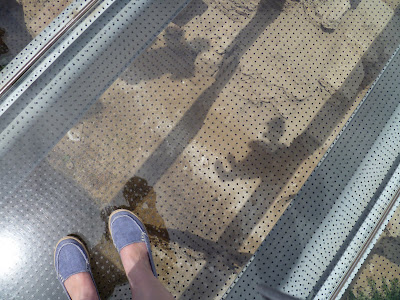 First, at the base of the Acropolis on the southeastern side we found the Theater of Dionysus. Dionysus, as you may know, was the god of theater, wine, and good old fashioned partying.
First, at the base of the Acropolis on the southeastern side we found the Theater of Dionysus. Dionysus, as you may know, was the god of theater, wine, and good old fashioned partying.This open air theater was one of the earliest theaters in the world, where plays were performed at festivals in honor of the god Dionysus. It served as kind of a prototype for all other theaters built in Greece. It was the first stone theater ever built, and was also the birthplace of Greek tragedy.
 Next on our tour was a more modern theater, one that is even still used today (Yanni anyone?). The Odeon of Herodes Atticus was built by the Romans in 161 AD.
Next on our tour was a more modern theater, one that is even still used today (Yanni anyone?). The Odeon of Herodes Atticus was built by the Romans in 161 AD.From there, we hiked on up to the top of the great Acropolis. For those of you not in the know, acropolis literally means "the highest point of the town." Every city has an acropolis, but this one gets all the glory.. for obvious reasons.

First thing's first: the Propylaea, which serves as the gateway to the Acropolis. Like any other Propylaea (which is literally just an entrance), visitors who passed through had to be ritually "cleaned" in order to enter.
 The ones you see here are not the originals, they're replicas. Only five of the original six are still in Greece, which are housed inin the Acropolis Museum. The sixth was taken by Lord Elgin in the early 1800s to decorate his home, and can now be seen in the British Museum of London (along with many other Acropolis artifacts-- much to the Greeks' dismay). Unfortunately, I don't have a snapshot of the originals-- the Acropolis Museum didn't allow photos, and I didn't make it to London (this time!). Despite all this, these lovely maidens were my favorite part of the Acropolis Experience. Each of the statues has its own distinct hairstyle, while still maintaining similarity with the rest. Also, notice how they are still very slender and feminine, even though they are supporting the weight of the porch roof.
The ones you see here are not the originals, they're replicas. Only five of the original six are still in Greece, which are housed inin the Acropolis Museum. The sixth was taken by Lord Elgin in the early 1800s to decorate his home, and can now be seen in the British Museum of London (along with many other Acropolis artifacts-- much to the Greeks' dismay). Unfortunately, I don't have a snapshot of the originals-- the Acropolis Museum didn't allow photos, and I didn't make it to London (this time!). Despite all this, these lovely maidens were my favorite part of the Acropolis Experience. Each of the statues has its own distinct hairstyle, while still maintaining similarity with the rest. Also, notice how they are still very slender and feminine, even though they are supporting the weight of the porch roof.  |
| Sooooo many people.. including Danielle and Robyn! |
Myth has it that the people chose Athena over Poseidon as their protector after a competition between the two. The deal was that each would give a gift to the Athenians, and they could choose whichever they liked best. Poseidon, being the god of the sea, struck his triton into the ground and salt water came out... which is pretty much good for nothing. Athena, however, presented them with an olive tree, which provides wood, food, and oil.
Anywho, this temple here is more like the Parthenon 2.0. The original temple dedicated to Athena was destroyed during the Persian invasion of 480 BC. Parthenon 2.0 was completed in 438 BC.
In the 6th century AD it was converted to a Christian church dedicated to the Virgin Mary, and was later turned into a mosque in the early 1460s (a minaret was even built in it). In 1687, Venetian bombs severely damaged the temple and the sculptures inside.
Then, in the early 1800s, our favorite Lord Elgin took many of the sculptures that survived the bombings, which can now also be found in the British Museum of London. The Acropolis Museum just has copies. Obviously this doesn't sit well with the Greeks, who are determined to get them back (and rightly so!).. but it doesn't look good.
Alright, I have to stop myself. There are manymany things to talk about when discussing the Parthenon. But that would take forever, and I'm still only on day two. Basically, what I want you to get from this is that some British dude ransacked the Acropolis and the Greeks aren't happy about it. Good? Good.
Oh hey look! See-through floors outside of the Acropolis Museum:
 |
| The first floor of the museum is like this, too, but we couldn't take pictures inside |

0 comments:
Post a Comment